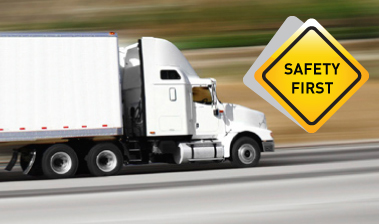By Sandy Long
Trucking is dangerous in many ways. Accidents with other vehicles can happen in a heartbeat. Occupational injuries often happen to truckers. And to criminals, truckers are attractive targets. Protecting yourself from danger takes common sense, knowledge, and attention to everything in your environs.

A safe driver is always watching everything going on around them on the highway. While doing so, other things they are taking in besides traffic is the type of shoulder, whether the median and bar ditch is flat or deeply ditched, and what obstacles are there near the roadway. This is called ‘looking for an out’ in case the driver needs to dodge quickly to avoid an emergency situation, such as a car coming across the median at them or a car stops suddenly in front of them.
One of the top occupational injuries that happen to truckers is falling out of the truck or trailer, or falling down on ice in winter. Truckers should always have three points of contact when entering or leaving the truck. This means a hand on the steering wheel, grab bar, and a foot on the steps. Getting in and out of the trailer, it pays to invest in a short stepladder instead of trying to climb in and out. In the winter, wear shoes or boots with good tread, or invest in ice grippers that go over shoes to provide traction.
With the bad economy, criminals are looking everywhere for easy targets. The first step to avoid becoming a victim is to always be aware of your surroundings and anyone in it. If a trucker is at a truck stop or rest area, especially at night, then they should be looking for people acting furtive. For example, someone standing between trailers or a car moving slowly through the truck parking area. If the driver is in their truck and sees suspicious activity, they should call the truck stop and tell them what they are seeing, or call 911. If the driver is out of their truck and see this type of activity, they should go back inside either their truck or the building, whichever is closest, and again report it.
Warehouses present some issues because the driver may have to go inside at night. If it is not a secure facility behind security fencing with a guard, then again, the driver needs to be aware of any movement that looks suspicious. Park as near to the shipping/receiving door as possible long enough to check in unless there is a staging line. Drivers have been attacked as they open and close the trailer doors, so always be completely alert during those times.
While a trucker is loading, day or night, they need to be watching to see if anyone is paying undue attention to them, or hanging around. Once loaded, a driver needs to watch to see if a car pulls out and follows them. A driver should not stop for at least 100 miles after loading unless absolutely necessary. Hijackers know what a warehouse loads, so many will hang out on the street and watch for a driver not paying attention to follow and then hijack them.
Finally, many criminals are brazen. They will come up to a driver’s truck in broad daylight under the guise of begging for money or food. When the driver opens their door or window, the criminal strikes. While truckers have big hearts, it is better to help folks through charities than putting themselves, their equipment, and their cargo at risk.
Many truckers think that to protect themselves they need a gun. Not true. The best tools a driver has to protect themselves is their brain and their eyes. Of course, the little hairs on the back of the neck work, too. Too many drivers become complacent in their normal environment of truck stops, warehouses, and the highway. A complacent driver is a driver at risk.
